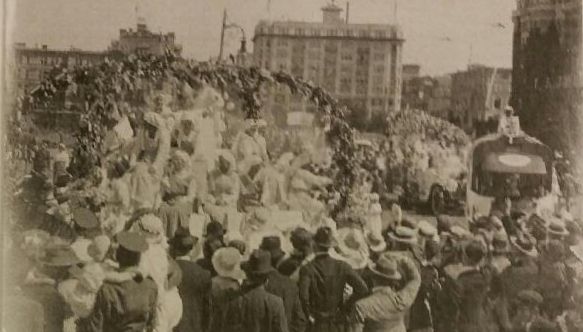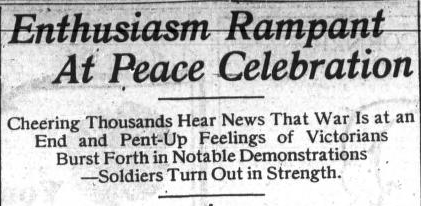 Raising Spirits
Raising Spirits
During the Great War many people would participate in events throughout the year which would help lift their spirits during the depressing atmosphere of wartime. When the war started in 1914, the Victoria Branch of the Red Cross was still under British control. It wasn’t until May 5, 1915 that the local Victoria Branch became part of the Canadian Red Cross as recognized in the branches’ first charter. This meant that the Victoria Red Cross was just starting to get more involved in the community, eventually participating and helping to organize local parades during and after the war.
Victoria Day: May 25, 1918
The war was still being fought during the spring of 1918, but this did not stop Victoria from engaging in a day of grand celebrations and amusement. The Victoria Day parade had been celebrated in previous years and this year the parade was to be held downtown, specifically at the Royal Athletic Park. During these parades, there tended to be a crowning ceremony for a local citizen and in 1918, that citizen was Miss Evelyn Dutot. When Miss Evelyn was crowned, she was also presented with a $50 Victory Loan bond, which was a prize presented to the winning candidate in the recent popularity contest conducted by the Canadian Red Cross Society of Victoria. Miss Evelyn would have her coronation ceremony at the Royal Athletic Park and she would also end up participate in the parade with her own decorative float.
Miss Evelyn’s float was not the only one that received attention. There had been several floats from a wide range of organizations represented in the parade with the Red Cross being one of them. The various Red Cross units under the central branch were either represented by one of these floats or by motor cars, with the James Bay unit having several, which included the Muggins float, Mrs. Woodward’s beloved pet. This float would later go on to win the prize of third place. Aside from the Muggins float, the North Ward unit had a float representing the hospital ward with a banner reading: “The Best Mother in All the World”. The Fernwood Red Cross workers would also have a float and the Fairfield unit would be represented as well.
Even though the Red Cross would be remembered for its impressive floats during the parades, the Victoria branch had also participated in other activities that occurred throughout the day of celebrations. At the entrance of the park, the various Red Cross units had set up a row of attractive booths. The women occupying one particular booth were: Miss Pooley, Mrs. H. Fleming, Miss Hilda Fleming, Mrs. Gibson, and Miss Babington. At this booth, the women were selling peanuts, fruit, and tea biscuits. The James Bay unit had a home-cooking stall which was also ran by a fair number of women under the supervision of Mrs. R. McMorran. This unit also had a raffle stall with Mrs. C.N Cameron in charge. The Fairfield unit had a booth and it was under the supervision of Madame Webb where it sold: gum, candy, popcorn, and raffles. Ice-cream and tea were also popular throughout the day with other local units selling them. The North Ward unit under Mrs. C. W. Bradshaw sold ice-cream with help from the girls from the North Ward School. The Fernwood unit under Mrs. A. B. Hudson sold tea and raffles. Lastly, the Gordon Head unit under control of Mrs. T. Todd, Mrs. C. Grant, and Mrs. B. Little ran a general store which proved to be effective in raising funds. The activities of the day continue into the evening and the Victoria Red Cross had another event for the public to attend. This event was the Red Cross dance and it took place at the Empress Hotel, where it proved itself to be both enjoyable and profitable.
Victoria Day: May 25, 1919
Exactly one year after the previous parade the war was over and the dynamics of the parade had changed. There was now a greater representation by the army and the navy during the 1919 parade, with tanks even joining in the march itself. This parade had also been different in that the floats were decorated in much greater detail than ever before. The Red Cross captured the attention of onlookers as stated by the Colonist: “Like something out of a fairy story was the Red Cross float, in white and scarlet and pulled by four snow-white horses harnessed in white”. The horses were led by Mr. Albert Jeeves, while the actual float was created thanks to the hard work done by Mrs. Woodward, Mrs. Baker, and Private Harry Baker. Other than the Muggins float, the Red Cross was also involved in the veterans display. The veterans float was covered in poppies and the soldiers were told to recite the famous poem by John McRae, “In Flanders Fields”. When the poem was being read, two Red Cross nurses, crippled soldiers, and sailors filled the tiers of the float. At the end of the parade the results of the best floats came in and the Red Cross won third place yet again for its Muggins display. Sadly this would be Muggins’ last Victoria Day parade as he would pass away in January 1920.
Other Parades
Although the Victoria Day parades are the most notable and the most grand, the Red Cross did participate in other parades during the period from 1914-1920. One such parade was the Victoria Loan Parade on November 12, 1917. This parade was more about raising money for the injured men fighting overseas rather than a parade of celebration such as that of the Victoria Day Parades. The Red Cross had a float and it featured Red Cross women hard at work with a dispatch wagon full of goods ready to ship overseas.

Another parade the Red Cross participated in was the Peace Parade on November 11, 1918 – the day the Armistice was signed with Germany. In this parade, Muggins was situated on top of a motor with his owner Mrs. Woodward. A banner overhead stated that he had raised over $10,000 for the Red Cross and this gave him special recognition to many in the crowds that gathered.

References
Big Parade Heralds Loan Drive Success.” The Daily Colonist (Victoria). 13 November 1917. http://archive.org/stream/dailycolonist59y290uvic#page/n29/mode/1up/search/victoria+parade.
“Enthusiasm Rampant At Peace Celebration,” The Daily Colonist (Victoria). 12 November 1918. http://archive.org/stream/dailycolonist60y294uvic#page/n6/mode/1up/search/parade+day+victoria+paraded.
“Ideal Holiday For Victorians.” The Daily Colonist (Victoria). 25 May 1918. http://archive.org/stream/dailycolonist60y145uvic#page/n6/mode/1up/search/red+cross+parade+crossing.
“Pageant Leads Off Days Celebration.” The Daily Colonist (Victoria). 25 May 1919. http://archive.org/stream/dailycolonist61y138uvic#page/n0/mode/1up/search/red+cross+parade+paraded.
